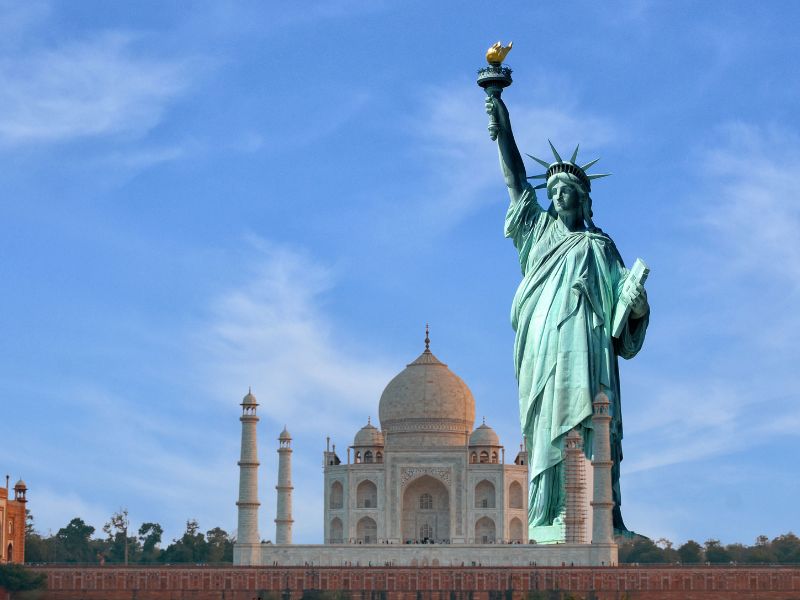.png)

Ajay Srivastava, founder of Global Trade Research Initiative, is an ex-Indian Trade Service officer with expertise in WTO and FTA negotiations.
January 30, 2025 at 9:20 AM IST
While China, Mexico, and Canada are at the top of US President Donald Trump's list for higher tariffs, India remains on alert as he has labeled the country the "Tariff King." He has accused India of imposing high tariffs on US goods and has promised reciprocal measures.
The US is India's top trading partner, with exports to the US rising 46% from $53.1 billion in 2019-2020 to $77.5 billion in 2023-2024, driven by strong US demand. Any new US tariffs would hurt Indian exports, though the extent of the impact would depend on the specific products targeted and the tariff levels imposed.
While Trump's exact course of action against India remains uncertain, India could take seven key steps to prepare. Tariff-related measures will fall under the Finance Ministry, while other responses will require coordination across multiple ministries.
Lower Tariffs
While Trump's label of India as a "tariff king" may be exaggerated, a strategic tariff review could benefit India by supporting low-cost, value-added manufacturing and trade India’s customs duties, once a significant contributor to government revenue, now account for just 6.4% of the gross tax revenue, compared to corporate tax (26.8%), income tax (29.7%), and GST (27.8%). Given the declining share of customs duties, they are no longer a key revenue pillar and it is time to re-evaluate tariffs as a strategic tool to support domestic manufacturing and global trade.
Lowering India’s average tariff to around 10% can be achieved without major revenue loss. Currently, 85% of tariff revenue comes from just 10% of tariff lines, while 60% of tariff lines contribute less than 3% of revenue. Simplifying the tariff structure by reducing slabs from over 40 to 5, capping maximum tariffs at 50%, and ensuring raw materials are taxed lower than finished goods would foster economic growth, reduce import reliance, and promote exports. An inter-ministerial review of tariff policies would help refine India’s tariff framework, avoid international scrutiny, and align tariffs with national goals.
Make In India
All tariff fight is over doing more domestic manufacturing and wresting some from China. Trump is expected to boost U.S. manufacturing subsidies, through initiatives like the Inflation Reduction Act, sidestepping WTO rules. India can take this as a cue to strengthen its Make in India program, focusing on deeper manufacturing rather than surface-level assembly.
No to IPEF
Trump's trade policy has leaned toward protectionism, as seen in the US withdrawal from the Comprehensive and Progressive Agreement for Trans-Pacific Partnership (CPTPP) in his previous term. While his stance on tariffs is unlikely to soften, he may urge India to join the "Trade Pillar" of the Indo-Pacific Economic Framework (IPEF). In this 14-nation deal, India has already committed to three out of four areas.
India has wisely opted out of the IPEF Trade Pillar as it restricts domestic policies around digital trade and labour standards without offering tariff-cut benefits. IPEF, perceived by some as a US-driven framework with limited flexibility, could undermine India's policy autonomy. India should not change its stand.
Diversify IT Exports
Trump's criticism of outsourcing and his stricter policies on H-1B visas raise challenges for India's IT sector, which relies on the U.S. for 80% of its export revenue. Potential restrictions on outsourcing could impact earnings for Indian IT firms and make it harder to hire skilled talent. Additionally, Trump's strict immigration stance may complicate visa processes, increasing costs and operational hurdles for Indian companies and limiting the movement of skilled professionals on short-term U.S. assignments.
To mitigate these risks, India's IT sector should diversify beyond the U.S., expanding operations into other markets and focusing on higher-value services like digital transformation and AI integration for global industries.
Data Policies
American tech companies favour the free flow of data across borders. Trump may pressure India to adopt more open data-sharing policies. At the WTO, the U.S. could push India to join the Joint Statement Initiative on e-commerce, aligning with its vision of unrestricted data movement.
Data is the raw material for the new AI-driven economy. China considers data a factor of production like land, labour, and capital and does not share it with global firms. India should resist external pressure to share data freely. By retaining control over its data policies, India can support domestic innovation, protect citizens' privacy, and ensure data sovereignty in an increasingly digital economy. A cautious, balanced approach to data-sharing policies will help India build a competitive edge while safeguarding its strategic interests.
Energy Transition
As Trump withdrew from the Paris Agreement, India might consider re-evaluating its ambitious 2030 goal of generating 500 GW of renewable energy. Meeting this target is challenging, given India's heavy reliance on imported Chinese solar cells. Without domestic alternatives, India's solar equipment import bill could soar from $7.5 billion to $30 billion by 2030.
India and the U.S. heavily rely on China for solar panels, highlighting the need for India to work with the U.S., EU, and Japan to create a large-scale solar manufacturing base within India. This partnership would lessen global dependence on China and aid clean energy efforts.
Reciprocity
If the U.S. takes unwarranted actions, India should be prepared to respond—something it has successfully done before. For instance, in March 2018, when the U.S. imposed tariffs on Indian steel and aluminium, India countered by raising tariffs on 29 specific American products. This response was carefully calibrated to ensure that India collected equivalent revenue from U.S. imports as the U.S. did from Indian steel and aluminium. Such measured retaliations demonstrate India's commitment to protecting its trade interests while maintaining a balanced approach.
Retreating Leadership
For decades, the United States led the creation of global institutions like the United Nations, World Bank, IMF, WTO, WHO, and UNFCCC. These initiatives fostered international cooperation. For example trade rules helped global trade grow from under $100 billion to over $33 trillion in 75 years, benefiting economies worldwide. However, recent U.S. actions indicate a retreat from this leadership role, focusing instead on domestic priorities. America blames the world for most of its woes while turning inward.
This shift was evident in Trump’s announcements on January 20, including withdrawing from the Paris Agreement and the WHO. His new "America First" trade policy is built on the belief that trade imbalances are caused by unfair practices from U.S. partners. For Trump, a country exporting more to the U.S. than it imports must be blocking American goods, warranting higher tariffs. Yet, his high-tariff strategy, implemented since 2018, has backfired.
Tariffs Fail
While we talk about another tariff war based on Trump’s frequent statement, we hope the US realises that it did not win the last round of tariff war.The U.S.-China trade war began in March 2018 when President Trump imposed 25% tariffs on steel and 10% on aluminium, later expanding them to hundreds of Chinese goods to address trade imbalances and boost domestic manufacturing.
While imports from China dropped by $81.56 billion between 2017 and 2023 (from $519.52 billion to $437.96 billion), total US imports rose by 31.51%, increasing by $763.2 billion to $3.04 trillion. About 57% of this growth came from Mexico, Canada, and ASEAN countries, benefiting from zero tariffs under agreements like the U.S.-Mexico-Canada Agreement and the U.S.-Vietnam FTA. India's exports to the US also grew by $36.8 billion during this time.
The above data shows that Trump's tariffs failed to revive US manufacturing. Instead, they vastly increased its global imports. Many goods originating from China or produced by Chinese firms in Mexico or ASEAN countries entering the US tariff-free.
Let us hope, the US sees this logic. If this happens, it may reconsider its tariff strategy and adopt more effective strategies for promoting local production and jobs and cutting China's trade influence.




